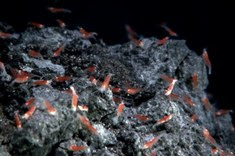Extreme Life
From bacteria that can survive inside rocks to microbes that can withstand tremendous heat, cold and radiation, life can take some extreme forms. These enterprising creatures reveal not just the resilience of life on Earth, but the possibilities for life elsewhere in the universe. Here are some especially amazing examples of so-called extremophiles.
Not a drop to drink
Some organisms, such as Dunaliella algae discovered in 2010 in a cave in Chile's Atacama desert, can thrive on very little water. Despite living in the driest place on Earth, these mooching microbes grow on top of spiderwebs to capitalize on dew – the meager amounts of air moisture that condense on the webs in the mornings.
Hot stuff
So-called hyperthermophiles are species that thrive in extremely hot environments. The Aquifex genus of bacteria, for example, has been found living in hot springs in Yellowstone National Park, where temperatures can reach 205 degrees Fahrenheit (96 degrees Celsius).
Frugal living
One extreme species, the Thermococcus microbe, can survive on so little energy that until now the chemical reaction it uses wasn't thought able to sustain life. These organisms were found living near deep-sea hydrothermal vents where super-hot water seeps out of the Earth's crust near Papua New Guinea. In addition to their thrifty use of energy, the microbes can survive in extreme temperatures too scorching for most creatures.
Pass the salt
Talk about high sodium! Salt-tolerant "halophilic" microorganisms can withstand salt concentrations that would wither most life. One example is the bacteria Halobacterium halobium, which has evolved to live in environments with 10 times more salt than seawater, such as the salty lakebed of California's Owens Lake.
Brrr, it's cold in here
Some microbes, called psychrophiles, found in polar ice, glaciers and deep ocean waters can withstand frigid temperatures as low as 5 degrees Fahrenheit (minus 15 degrees Celsius). They consist mostly of bacteria, fungi and algae, and contain enzymes that are adapted to function at low temperatures. They have been found, for example, in the frozen Arctic and Antarctic Oceans and beneath sheets of ice in Siberia.
Radiation proof
Other extreme species prove their mettle by withstanding intense amounts of radiation. For example, the Deinococcus radiodurans bacterium can survive a 15,000 gray dose of radiation, where 10 grays would kill a human and it takes over 1,000 grays to kill a cockroach. This species, in fact, is exemplary in many ways, encompassing also the ability to survive cold, dehydration, vacuum and acid. The Guinness Book of World Records lists D. radiodurans as the world's toughest bacterium.
Between a rock and a hard place
Endoliths are organisms that live inside rocks or other spots thought impermeable to life, such as in crevices of animal shells or the pores between grains of minerals. These species have been found over 2 miles (3 km) below the Earth's surface, and may live even deeper. Water is scarce at these depths, but some studies suggest they feed on surrounding iron, potassium, or sulfur. While their choice of abode presents some limitations, it also provides protection from harsh winds and radiation from the sun.
No oxygen
This newfound creature, a loriciferan identified as an undescribed species of the genus Spinoloricus. The creature has specialized organelles so that it can survive without oxygen. Scale bar is 50 microns.
Source: http://www.livescience.com
Frugal living
One extreme species, the Thermococcus microbe, can survive on so little energy that until now the chemical reaction it uses wasn't thought able to sustain life. These organisms were found living near deep-sea hydrothermal vents where super-hot water seeps out of the Earth's crust near Papua New Guinea. In addition to their thrifty use of energy, the microbes can survive in extreme temperatures too scorching for most creatures.
Pass the salt
Talk about high sodium! Salt-tolerant "halophilic" microorganisms can withstand salt concentrations that would wither most life. One example is the bacteria Halobacterium halobium, which has evolved to live in environments with 10 times more salt than seawater, such as the salty lakebed of California's Owens Lake.
Brrr, it's cold in here
Some microbes, called psychrophiles, found in polar ice, glaciers and deep ocean waters can withstand frigid temperatures as low as 5 degrees Fahrenheit (minus 15 degrees Celsius). They consist mostly of bacteria, fungi and algae, and contain enzymes that are adapted to function at low temperatures. They have been found, for example, in the frozen Arctic and Antarctic Oceans and beneath sheets of ice in Siberia.
Radiation proof
Other extreme species prove their mettle by withstanding intense amounts of radiation. For example, the Deinococcus radiodurans bacterium can survive a 15,000 gray dose of radiation, where 10 grays would kill a human and it takes over 1,000 grays to kill a cockroach. This species, in fact, is exemplary in many ways, encompassing also the ability to survive cold, dehydration, vacuum and acid. The Guinness Book of World Records lists D. radiodurans as the world's toughest bacterium.
Between a rock and a hard place
Endoliths are organisms that live inside rocks or other spots thought impermeable to life, such as in crevices of animal shells or the pores between grains of minerals. These species have been found over 2 miles (3 km) below the Earth's surface, and may live even deeper. Water is scarce at these depths, but some studies suggest they feed on surrounding iron, potassium, or sulfur. While their choice of abode presents some limitations, it also provides protection from harsh winds and radiation from the sun.
No oxygen
This newfound creature, a loriciferan identified as an undescribed species of the genus Spinoloricus. The creature has specialized organelles so that it can survive without oxygen. Scale bar is 50 microns.
Source: http://www.livescience.com


















No comments:
Post a Comment